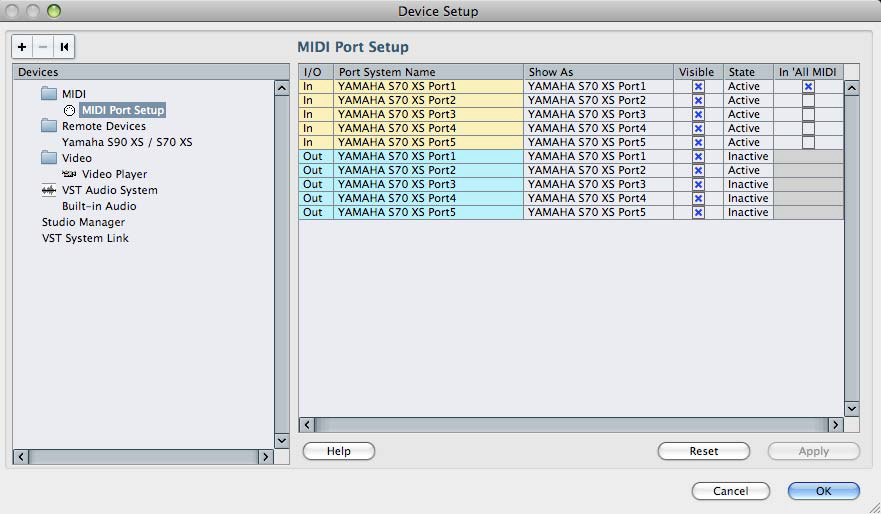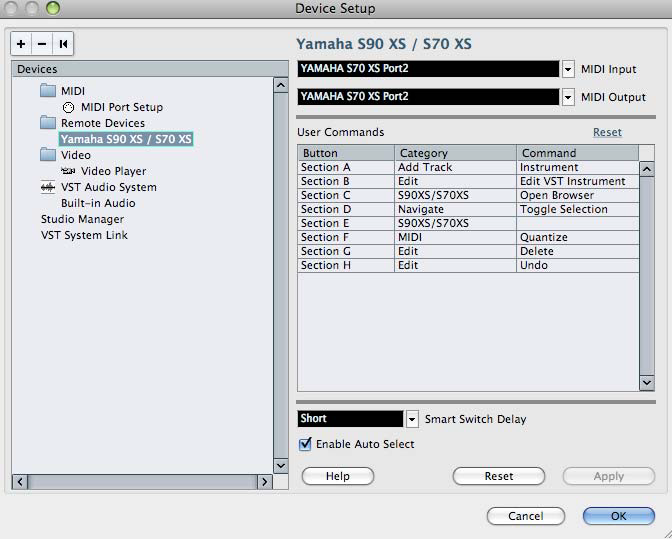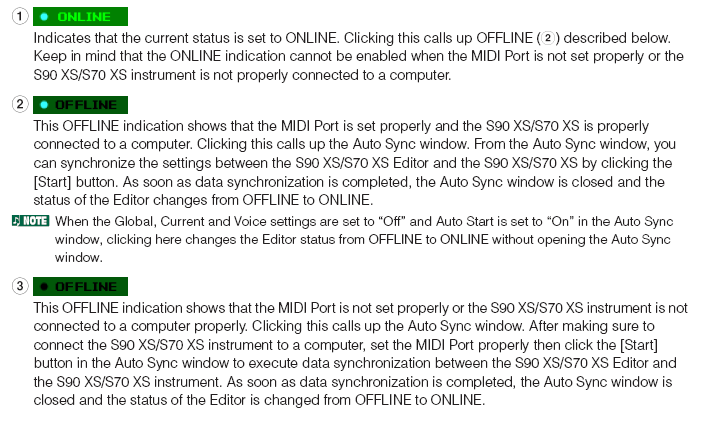This guide will take you through setting up your computer for MIDI communication with the S90 XS/S70 XS. This will facilitate MIDI recording and use of the Editor VST. (The Editor can be used with or without Cubase). It can be run as a standalone application. Or, as is outlined in this article, Cubase can encompass the Editor as a VSTi – which runs inside the DAW’s environment. The advantage in addition to all the signal routing and processing functions is that you do not have to bother save a separate file for your synthesizer, because when you save your Cubase Project it will automatically save all the settings for your S90 XS/S70 XS and keep them bundled together in the Cubase Project (.CPR) file. This means when you reopen the Project you can have the Editor’s total recall feature restore all the settings to your synthesizer just as they were when you completed work.
A word about AUDIO
The USB-MIDI connection is MIDI only. It does not allow you to route audio from the synthesizer into the computer. In order to transfer audio data in real time (i.e., record AUDIO TRACKS) you will need a separate audio interface.
The S90 XS/S70 XS offers you several ways to record audio data. Audio data, of course, is used to create .wav files that are used for audio CDs. Audio data can be turned into MP3 files that, due to their reduced size, are convenient for posting on websites or emailing to friends.
The subject of creating AUDIO data will be in a separate article.
Install, Activate and Register your copy of “Cubase AI” on your computer
Download and install the following software from the Official Yamaha Download site:
Download and install the latest “S90 XS/S70 XS Remote Tools”
Download and install the latest “S90 XS/S70 XS Editor Standalone/VST”
Download and install the “Yamaha USB-MIDI driver” for your particular computer type and operating system.
The editor requires multiple ports to connect with the S90 XS/S70 XS, therefore you MUST use USB-MIDI to utilize editors.
Connect via USB
• Connect the XS to your computer via USB.
Set the XS to MIDI IN/OUT = USB
• Press [UTILITY]
• Select “MIDI”
• Press [ENTER]
• Cursor down to MIDI IN/OUT
• Set MIDI IN/OUT = USB
• Press [STORE] to write this to your Flash ROM
Launch Cubase AI
• Click DEVICES
• Select DEVICE SETUP…
• Under the “MIDI” folder highlight “MIDI PORT SETUP”
• You should see your Yamaha S90 XS/S70 XS PORTS.
The example below uses an S70 XS
• Select only “Yamaha S70 XS Port1” as the “In ‘All MIDI Inputs'”

You do not have to worry about the “State” (Active/Inactive) as this is only a current status report. You do not want to have Port 2 marked in the IN ALL INPUTS column as this is reserved for REMOTE CONTROL functions. If you have another controller keyboard plugged into the MIDI IN jack of the XS, you could possibly activate Port 3 (this is the so-called “THRU PORT”). The “In ‘ALL INPUT'” function is for your keyboard or MIDI controllers only. This is the data that will be recorded to a Cubase MIDI Track.
• Under the “Remote Devices” folder highlight “Yamaha S90 XS/S70 XS”
If it does not appear click on the big “+” symbol in the upper left and ADD the “Yamaha S90 XS/S70 XS” device.
• Set it to Port 2 (YAMAHA S70 XS Port2) for both MIDI INPUT and MIDI OUTPUT

If you are using an audio interface connect that now under the “VST Audio System”. Use the driver that is appropriate for your interface. If you are only recording MIDI you do not need an audio interface (in which case you can skip this step).
• Click APPLY
• Click OK
• On the Cubase Toolbar click on DEVICES
• Select VST INSTRUMENT from the drop down menu
• In the “instrument rack”, click in an empty space and select EXTERNAL > S90XS/S70XS VST
This will launch the Editor VST application within Cubase.
• Go to FILE > SETUP on the Editor toolbar.
Here you want to setup the communication between the XS and the Editor.
• Select USB as the DATA PORT
• Set the DETAIL = ON (shown below)
Make settings for Port 1 and Port 4.

Next you make a decision about the direction of communication. There are two things to consider:
1) When you open a New Project in Cubase, how do you want the Editor to behave?
2) When you open a previously saved Project, how do you want the Editor to behave?
Typically, when you create a New Project you will want the Editor to clear a new MULTI for you. Therefore you will want to have data sent FROM the Editor TO the XS. When you are restoring a previously saved Cubase Project you will want the Editor to send your saved data back to the XS. Therefore you will want to have data sent FROM the Editor TO the XS.

As you can see I have the “Auto Sync Setting” set so both GLOBAL and CURRENT are going from PC > XS
This is so that the Total Recall function will send the UTILITY settings and the current MULTI from the computer to the XS when I open a Cubase Project. Restoring my MULTI to my XS. It will send an initialized MULTI setup to the XS when I create a New Project. Cool!
I have the VOICE option set to OFF, as I don’t often need to reload all the User Voices (but you can set this as your prefer). If set to ON, then the Editor can restore all your USER1, USER2, USER3 and USER Drum Kit Voices to your XS each time. It is your choice. If you have used a unique Library of sounds, they too can be recalled when you open the Cubase Project. These settings are important and should be considered on a per Project basis.
“Auto Start” is ON. You may opt at some point to turn this OFF. Until you are used to how the EDITOR works you may wish to leave AUTO START set OFF. When ON, synchronization takes places automatically.
Set the “GENERAL SETTING” area as you prefer. The “Keyboard Velocity” function when set to “FREE” will change how loud the note plays by where on the keyboard icon KEY you click. This is pretty cool…
• Click OK
ONLINE/OFFLINE
Clicking this radio button switches the status of the Editor between “ONLINE” and “OFFLINE.” When “ONLINE” is indicated, the edited status is completely synchronized between the S90 XS/S70 XS Editor and the S90XS/S70 XS instrument, meaning that any parameter edit you make on the S90 XS/S70 XS Editor is reflected in the same parameter on the S90 XS/S70 XS instrument and vice versa. When OFFLINE is selected, editing on the S90 XS/S70 XS Editor will not affect the S90 XS/S70 XS instrument and vice versa even if the S90 XS/S70 XS instrument is connected to a computer.
Note that the indication here is automatically changed according to the status of communication between the S90 XS/S70 XS Editor and the S90 XS/S70 XS instrument. For example, the ONLINE status changes automatically to OFFLINE when the cable is disconnected accidentally.

On the main XS Editor screen you want to make sure that the Editor is ONLINE.
A bright dot appears next to ONLINE when you are communicating. In the left upper corner you will see the Modes: VOICE and MULTI followed by the “ONLINE” button.
Communication is bi-directional and simultaneous so selecting the mode here will change your hardware and vice-versa.
The OFFLINE w/bright dot indicator is important because you will at some point need to make changes on the hardware and not have the software follow you. This can occur when you are searching for a VOICE or PERFORMANCE in the XS – the Editor will attempt to synchronize each time you select something. Therefore it is useful to click this option (go OFFLINE) when you want to temporarily break communication. You can click ON and OFFLINE, as necessary.
If you change modes and go to PERFORMANCE mode on the XS hardware front panel, the XS Editor will go temporarily *OFFLINE w/bright dot. You can bring it back ONLINE when you return to MULTI mode by simply clicking the word “OFFLINE” – the AUTO SYNC window will open and re-establish communication.
On the Toolbar of the XS Editor you will see the BULK option. This is what you use to request a bulk to (Transmit) or from (Receive) the XS. You can select the Current MULTI, and any of the USER Banks or ALL of the USER Banks.
Do not change your preference in the FILE > SETUP > AUTO SYNC SETTING – when you need to send or receive data from the XS use this BULK option.
• Click BULK > DATA SYNC
Set the attributes that you wish to send or receive, then click “START”.
{soundcloud}https://soundcloud.com/mp-yamaha/s90xs-s70xs{/soundcloud}





